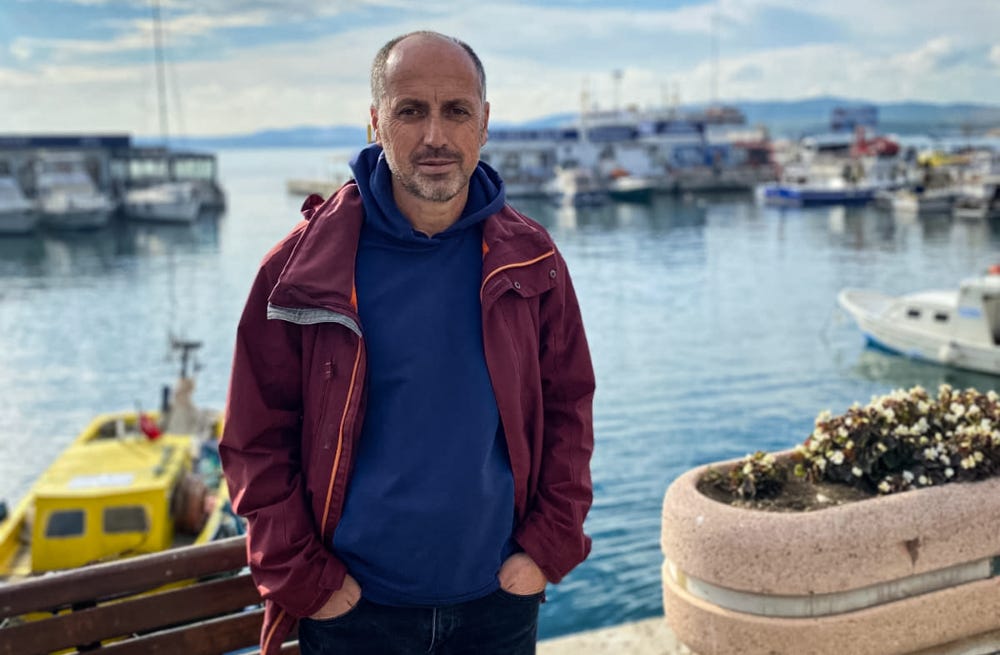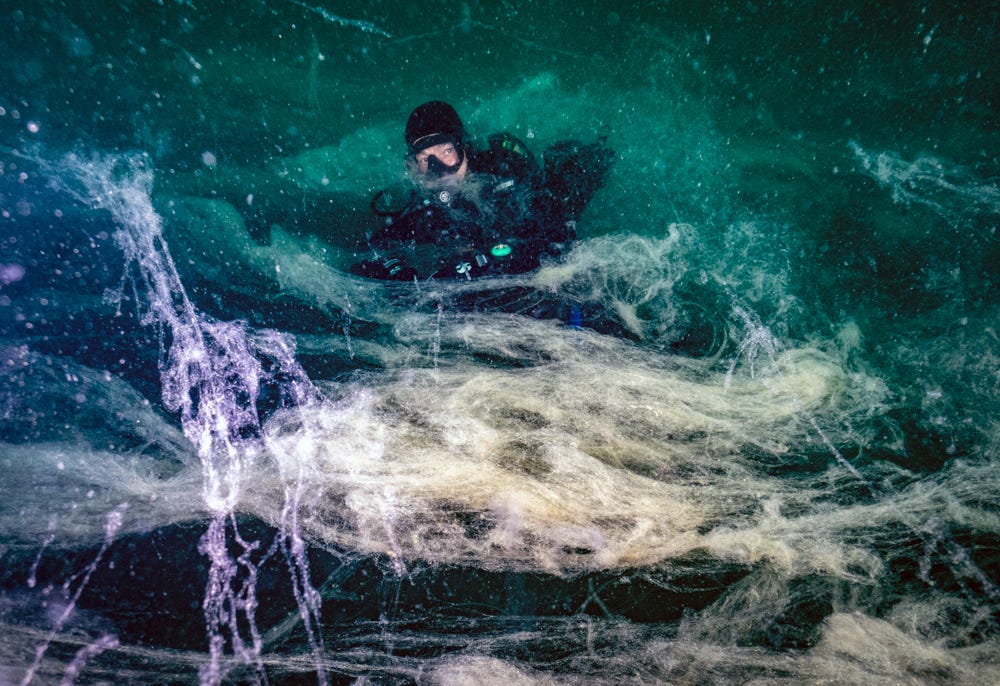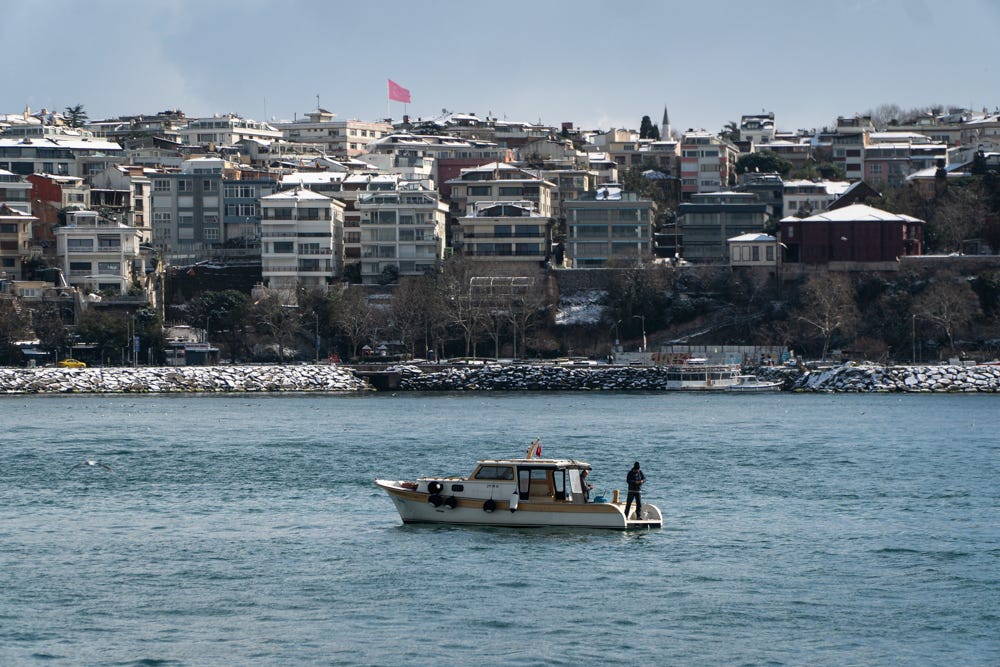İSTANBUL — Ecocide. Environmental disaster. Dead zone. Marine experts may debate the correct term, but their warning is unanimous: the Marmara Sea is in a dire state.
Following a summer outbreak in 2021, marine mucilage has returned to Turkey’s inland sea with an unprecedented winter surge that is choking aquatic life. Also known as ‘sea snot’, the mucilage is now rapidly spreading to the Aegean Sea and has likely entered Greek waters.
"It has spread across the entire Marmara in as little as 45 days," Mustafa Sarı, a professor at Bandırma's 17 Eylül University Faculty of Maritime Studies, told Turkey recap.
"Right now, it's everywhere. If you dive or just put your head underwater in the Marmara Sea, you'll see mucilage throughout the first 30 meters," he added.
Footage obtained by Turkey recap indicates a centimeters-thick, whitish layer of mucilage is currently blanketing parts of Turkey’s western seabed, sucking up oxygen and strangling seagrass, corals and fan-mussels across both the Marmara and Aegean seas.
Meanwhile, floating clouds of this sea snot — a product of rampant plankton growth mainly caused by pollution — creep through the water, clogging up fishing nets and wreaking havoc on the region’s seafood sector.
"It's a full-scale environmental disaster," Sarı said, predicting a repeat of the 2021 outbreak or worse.
With the resurgence of sea snot in cold winter months, experts and fishers fear marine life in the Marmara Sea could face a mass die-off event as temperatures climb this spring and summer, further fueling the mucilage. Adverting such an outcome will be difficult, they said, considering the root causes of mucilage remain largely unaddressed.
2021 revisited
The Marmara is the world’s smallest sea. It’s also home to Turkey’s most populated and most industrialized coastlines.
During the 2021 mucilage outbreak, the viscous slime expanded to over 12,000 hectares of water, at times reaching the surface and creating surreal scenes. In its wake, one fifth of all plants and animals died in the Marmara Sea.
Sponge and pen-shell communities were heavily impacted as fish and coral populations shrank by a quarter. At the same time, oxygen depletion on the seabed forced sharks and rays to the surface, where they are more vulnerable to fishing nets.
Since then, Marmara area municipalities and the Ministry of Environment launched an extensive action plan to tackle the primary triggers of mucilage, such as the dumping of untreated wastewater into the sea.
Investments in better wastewater management became a priority, yet improvement efforts still fall short as millions of cubic meters of untreated wastewater continue to feed the sea snot on a daily basis.
"This body of water is no longer the Sea of Marmara as we once knew it," Levent Artüz, a hydrobiologist who also heads the Marmara Environmental Monitoring (MAREM) project, told Turkey recap. "It can be more accurately described as a waste pit rather than a sea."
Meanwhile, the combination of colder surface temperatures and warmer underwater temperatures has allowed the mucilage to thrive quietly in the depths, hidden from public view, said Tahsin Ceylan, an underwater photographer who has documented the mucilage crisis for years.
"When it's not visible on the surface, humanity shows no sensitivity. People do not show interest in the tragedy happening in the deep," Ceylan told Turkey recap.
During his recent dives, Ceylan captured marine flora — seaweed, algae and seagrasses — vital to the world's oxygen production, dying beneath swathes of mucilage.
He also observed bottom-dwelling fish lying dead on the sea floor, their gills stuffed with the slime, while coral populations, including the endangered Eunicella cavolini, starved.
"The mucilage has covered the coral polyps, which normally feed on zooplankton carried by currents, making their [food collection] difficult," Ceylan said. "Many of them will likely die."
Video above captured by diver Selim Konya in early February 2025 near Gökçeada via Nuri Yılmaz.
Clogged nets
The sea snot resurgence has also disrupted fishing activities across the Marmara Sea and beyond, multiple fishing cooperatives told Turkey recap.
"It’s already having an impact because it has spread everywhere underwater," Bariş Uysal from Bursa's Fisheries Cooperatives Union told Turkey recap, noting that the mucilage has worsened over the months, cutting off oxygen and forcing fish to migrate.
"It has become a severe problem, especially for fishers, aquaculture farmers and mussel growers," Uysal added.
According to Nuri Yılmaz, chairperson of the Çanakkale Fisheries Cooperatives Union, thick sea snot layers – sometimes found as deep as 90 meters below the surface – are widespread, extending from the Çanakkale Strait to Enez near the Greek border. He said the mucilage has likely reached the shores of the Greek islands, Samothrace and Lemnos.
"This time of year is usually for cuttlefish fishing and other types of fishing. Different bottom nets are used, but when you cast a net, the mucilage clogs the mesh," Yılmaz told Turkey recap. "If your target was 100 kilograms, you might end up with just one, two, or five kilograms of cuttlefish."
The mucilage fills nets and obstructs baits, making fishing nearly impossible. Recent footage shared by Yılmaz shows nets coated with mucilage gathered near Gökçeada, one of Turkey’s Aegean islands.
"The longer the net stays in the water, the more mucilage accumulates on it," Yılmaz said. "It turns into a wall-like barrier, and when you pull it up, cleaning it takes too much time. In the end, you don't even bother casting the net."
Sea snot particularly hurts small-scale fishers, both Sarı and Yılmaz pointed out, as larger ships can move to other waters with more fish, while small boats cannot.
However, Yılmaz pins his hope on the present strong northerly winds, known as Poyraz, and currents to clear the mucilage soon. If the winter outbreak continues, it will cause anxiety among fishers, Yılmaz said.
Dead zone threshold
Human-driven causes such as rising sea temperatures, coupled with deficient wastewater management in the region – home to nearly a third of Turkey's population – have increased nitrogen and phosphorus levels in the water over the years.
This has severely disrupted the ecological balance of the stagnant inland sea — with narrow connections to the less salty Black Sea and the more saline Mediterranean — creating the perfect breeding ground for an overgrowth of algae and phytoplankton, Sarı from Bandırma 17 Eylül University explained.
"Normally, their population [phytoplankton] should be in the tens per unit volume, but under these conditions, it skyrockets into the millions," Sarı said, describing the microscopic, plant-like organisms.
This plankton secretes sugars that form the web-like substance known as sea snot – first observed in Turkey in 2007. At the same time, when these organisms decompose, the water's oxygen levels deplete — a process called eutrophication. This threatens marine life, potentially leading to the collapse of the ecosystem and transforming the water body into a 'dead zone' where few or no creatures can thrive.
Experts have warned that certain depths of the Marmara Sea have already surpassed the dead zone threshold, with dissolved oxygen (DO) levels falling below critical levels, disrupting marine life, and forcing aquatic flora and fauna to surface in search of higher oxygen concentrations in the water.
"Due to the exponential increase in cumulative pollution, DO levels had already dropped below the critical 5 mg/L threshold required for sustaining life years ago," Artüz said, noting that one of the primary reasons for this 'ecological genocide' started about 35 years ago when so-called deep sea wastewater discharges were first utilized.

Untreated wastewater
Introduced to the Marmara in 1989, deep sea discharges were designed to emit waste into the depths of the sea with expectations that undercurrents would carry disposed materials to the Black Sea. However, the waste often ended up in the Marmara Sea instead.
Moreover, as recently as 2020, a deep sea discharge facility was established in Tekirdağ. This included rerouting the highly polluted Ergene River to dump its wastewater directly into the Marmara Sea, bypassing its natural flow into the Aegean.
That project expanded over the years, with nearly half of Tekirdağ’s industrial zone now using the facility to collectively discharge around 300,000 cubic meters of treated wastewater into the sea daily. However, skepticism remains about the facility’s actual reduction of pollution, both in the river’s flow and in the wastewater being released into the sea.
"Instead of treating these chemical pollutants and returning the purified water to the river for agricultural use, authorities opted to transport the waste underground for 50 km and discharge it 47.5 m deep off the coast of Tekirdağ," Artüz said, emphasizing that the dumping of waste in the Marmara Sea should immediately be halted.
"If there is a fire, the first thing you do is extinguish it — everything else follows. What we need is action, not a plan,” he added, referring to the 2021 the Marmara Sea Action Plan.
Among other directives, the plan requires local administrations to upgrade their wastewater treatment plants by the summer of 2025 to reduce unfiltered outflows. As a result, dozens of new advanced biological treatment plants are being constructed around the Marmara Sea.
Meanwhile, several municipalities were fined in the past month for lagging behind on establishing new plants, with only 42 of 169 pledged facilities completed to date.
Additional inspections revealed that major metropolitan areas, such as İstanbul, were found to be releasing untreated sewage into the sea. Authorities also identified pollution violations in Bursa, Tekirdağ and Balıkesir.
"Currently, only 51.7 percent of the domestic waste from the 25 million people living around the Sea of Marmara undergoes advanced biological treatment," Sarı said, a mere 0.7 percent improvement from 2021.
"For industrial waste, the number is even lower – just 30 percent is treated," he added.
According to a 2024 report by the Ministry of Environment, İstanbul alone discharges over 4 million cubic meters of urban wastewater per day, with neighboring municipalities adding another estimated 1.5 million cubic meters on top of that.
"They must make greater efforts to reduce [the Marmara’s] pollution load," Sarı said, underlining this would require cooperation between government institutions and local municipalities.
"Stopping the sources of waste flowing into the sea is the only way we can fight mucilage," he added.
Sea snot solutions
Besides wastewater facilities, other scientific solutions are being developed to prevent further infestations. These include converting mucilage into gas, purifying the water with fan mussels, and using floating plant islands to remove nitrogen and phosphorus from streams flowing into the Marmara Sea.
"Reducing pollution carried by rivers is a key approach to improving and preventing eutrophication," Ayşegül Akpinar, a professor at Bursa Uludağ University working on the floating plant island project, told Turkey recap.
These islands, constructed with non-invasive plants, absorb various pollutants and their associated organisms, reducing the contaminants and their toxic effects.
While Akpinar believes the islands can play a significant role — with around 1,000 set to be established following the project's signing in mid-February 2025 — she cautions that such mitigation measures alone won't be enough to tackle the current pollution crisis.
"Our work represents an important approach to addressing the mucilage problem, however, it must be accompanied by other urgent measures for the Marmara Sea," Akpinar said.
The Ministry of Environment, İstanbul's Municipality and the Marmara Municipalities Union did not reply to requests for comment for this report.
Turkey recap is an independent, reader-supported newsletter that helps people make sense of the fast-paced Turkey news cycle. Contact us: info@turkeyrecap.com.
Subscribe here on Substack (or on Patreon for a student discount). Paid subscribers get full access to our recaps, reports, members-only chat and news tracking tools.
Turkey recap is produced by our staff’s non-profit association, KMD. We are an affiliate of the Global Forum for Media Development and aim to create balanced news that strengthens local media by supporting journalists in Turkey.
Diego Cupolo, Editor-in-chief
Emily Rice Johnson, Deputy editor
Azra Ceylan, Economy reporter





